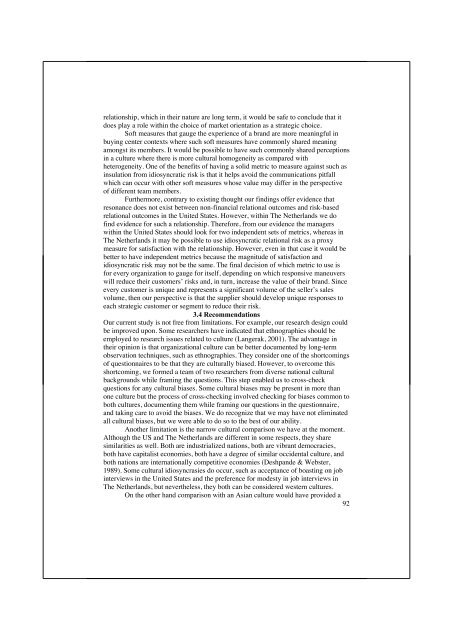Essays on supplier responsiveness and buyer firm value - Nyenrode ...
Essays on supplier responsiveness and buyer firm value - Nyenrode ...
Essays on supplier responsiveness and buyer firm value - Nyenrode ...
Create successful ePaper yourself
Turn your PDF publications into a flip-book with our unique Google optimized e-Paper software.
elati<strong>on</strong>ship, which in their nature are l<strong>on</strong>g term, it would be safe to c<strong>on</strong>clude that it<br />
does play a role within the choice of market orientati<strong>on</strong> as a strategic choice.<br />
Soft measures that gauge the experience of a br<strong>and</strong> are more meaningful in<br />
buying center c<strong>on</strong>texts where such soft measures have comm<strong>on</strong>ly shared meaning<br />
am<strong>on</strong>gst its members. It would be possible to have such comm<strong>on</strong>ly shared percepti<strong>on</strong>s<br />
in a culture where there is more cultural homogeneity as compared with<br />
heterogeneity. One of the benefits of having a solid metric to measure against such as<br />
insulati<strong>on</strong> from idiosyncratic risk is that it helps avoid the communicati<strong>on</strong>s pitfall<br />
which can occur with other soft measures whose <strong>value</strong> may differ in the perspective<br />
of different team members.<br />
Furthermore, c<strong>on</strong>trary to existing thought our findings offer evidence that<br />
res<strong>on</strong>ance does not exist between n<strong>on</strong>-financial relati<strong>on</strong>al outcomes <strong>and</strong> risk-based<br />
relati<strong>on</strong>al outcomes in the United States. However, within The Netherl<strong>and</strong>s we do<br />
find evidence for such a relati<strong>on</strong>ship. Therefore, from our evidence the managers<br />
within the United States should look for two independent sets of metrics, whereas in<br />
The Netherl<strong>and</strong>s it may be possible to use idiosyncratic relati<strong>on</strong>al risk as a proxy<br />
measure for satisfacti<strong>on</strong> with the relati<strong>on</strong>ship. However, even in that case it would be<br />
better to have independent metrics because the magnitude of satisfacti<strong>on</strong> <strong>and</strong><br />
idiosyncratic risk may not be the same. The final decisi<strong>on</strong> of which metric to use is<br />
for every organizati<strong>on</strong> to gauge for itself, depending <strong>on</strong> which resp<strong>on</strong>sive maneuvers<br />
will reduce their customers’ risks <strong>and</strong>, in turn, increase the <strong>value</strong> of their br<strong>and</strong>. Since<br />
every customer is unique <strong>and</strong> represents a significant volume of the seller’s sales<br />
volume, then our perspective is that the <strong>supplier</strong> should develop unique resp<strong>on</strong>ses to<br />
each strategic customer or segment to reduce their risk.<br />
3.4 Recommendati<strong>on</strong>s<br />
Our current study is not free from limitati<strong>on</strong>s. For example, our research design could<br />
be improved up<strong>on</strong>. Some researchers have indicated that ethnographies should be<br />
employed to research issues related to culture (Langerak, 2001). The advantage in<br />
their opini<strong>on</strong> is that organizati<strong>on</strong>al culture can be better documented by l<strong>on</strong>g-term<br />
observati<strong>on</strong> techniques, such as ethnographies. They c<strong>on</strong>sider <strong>on</strong>e of the shortcomings<br />
of questi<strong>on</strong>naires to be that they are culturally biased. However, to overcome this<br />
shortcoming, we formed a team of two researchers from diverse nati<strong>on</strong>al cultural<br />
backgrounds while framing the questi<strong>on</strong>s. This step enabled us to cross-check<br />
questi<strong>on</strong>s for any cultural biases. Some cultural biases may be present in more than<br />
<strong>on</strong>e culture but the process of cross-checking involved checking for biases comm<strong>on</strong> to<br />
both cultures, documenting them while framing our questi<strong>on</strong>s in the questi<strong>on</strong>naire,<br />
<strong>and</strong> taking care to avoid the biases. We do recognize that we may have not eliminated<br />
all cultural biases, but we were able to do so to the best of our ability.<br />
Another limitati<strong>on</strong> is the narrow cultural comparis<strong>on</strong> we have at the moment.<br />
Although the US <strong>and</strong> The Netherl<strong>and</strong>s are different in some respects, they share<br />
similarities as well. Both are industrialized nati<strong>on</strong>s, both are vibrant democracies,<br />
both have capitalist ec<strong>on</strong>omies, both have a degree of similar occidental culture, <strong>and</strong><br />
both nati<strong>on</strong>s are internati<strong>on</strong>ally competitive ec<strong>on</strong>omies (Deshp<strong>and</strong>e & Webster,<br />
1989). Some cultural idiosyncrasies do occur, such as acceptance of boasting <strong>on</strong> job<br />
interviews in the United States <strong>and</strong> the preference for modesty in job interviews in<br />
The Netherl<strong>and</strong>s, but nevertheless, they both can be c<strong>on</strong>sidered western cultures.<br />
On the other h<strong>and</strong> comparis<strong>on</strong> with an Asian culture would have provided a<br />
92
















